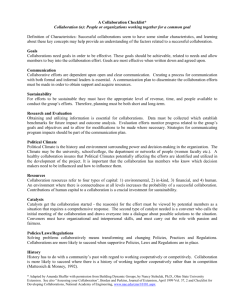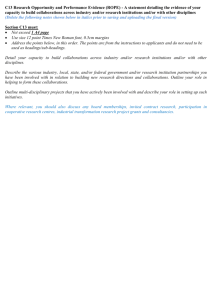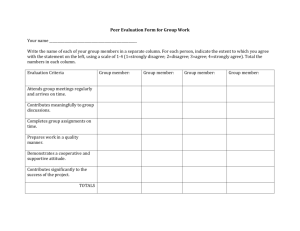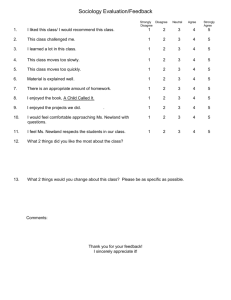A Collaboration Checklist
advertisement
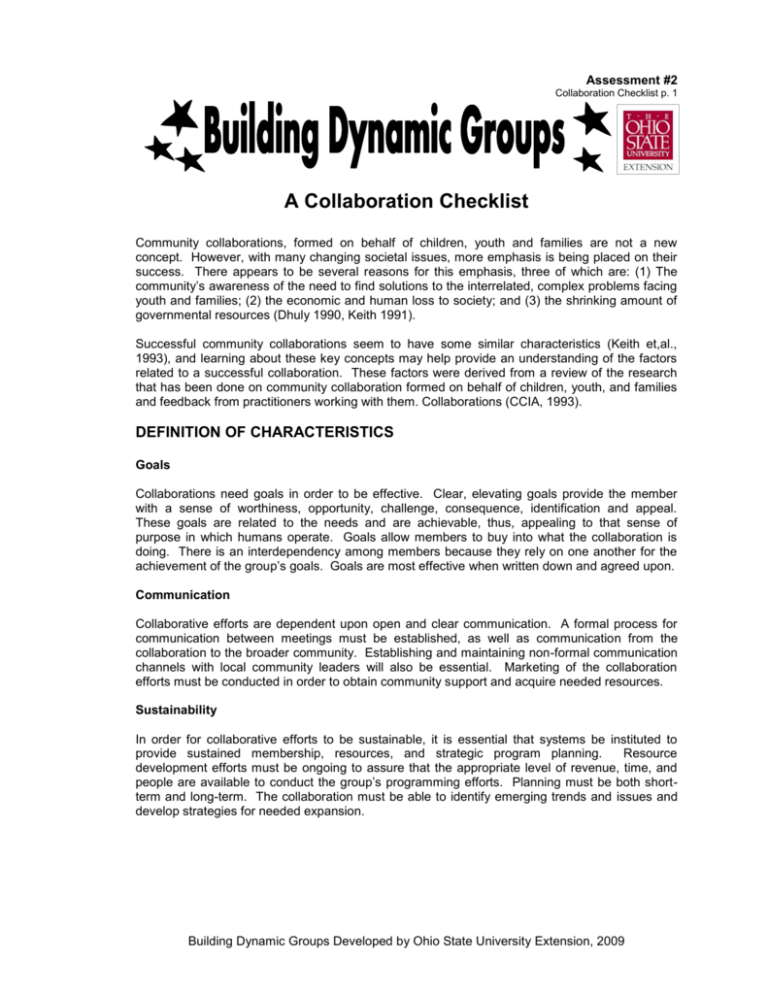
Assessment #2 Collaboration Checklist p. 1 A Collaboration Checklist Community collaborations, formed on behalf of children, youth and families are not a new concept. However, with many changing societal issues, more emphasis is being placed on their success. There appears to be several reasons for this emphasis, three of which are: (1) The community’s awareness of the need to find solutions to the interrelated, complex problems facing youth and families; (2) the economic and human loss to society; and (3) the shrinking amount of governmental resources (Dhuly 1990, Keith 1991). Successful community collaborations seem to have some similar characteristics (Keith et,al., 1993), and learning about these key concepts may help provide an understanding of the factors related to a successful collaboration. These factors were derived from a review of the research that has been done on community collaboration formed on behalf of children, youth, and families and feedback from practitioners working with them. Collaborations (CCIA, 1993). DEFINITION OF CHARACTERISTICS Goals Collaborations need goals in order to be effective. Clear, elevating goals provide the member with a sense of worthiness, opportunity, challenge, consequence, identification and appeal. These goals are related to the needs and are achievable, thus, appealing to that sense of purpose in which humans operate. Goals allow members to buy into what the collaboration is doing. There is an interdependency among members because they rely on one another for the achievement of the group’s goals. Goals are most effective when written down and agreed upon. Communication Collaborative efforts are dependent upon open and clear communication. A formal process for communication between meetings must be established, as well as communication from the collaboration to the broader community. Establishing and maintaining non-formal communication channels with local community leaders will also be essential. Marketing of the collaboration efforts must be conducted in order to obtain community support and acquire needed resources. Sustainability In order for collaborative efforts to be sustainable, it is essential that systems be instituted to provide sustained membership, resources, and strategic program planning. Resource development efforts must be ongoing to assure that the appropriate level of revenue, time, and people are available to conduct the group’s programming efforts. Planning must be both shortterm and long-term. The collaboration must be able to identify emerging trends and issues and develop strategies for needed expansion. Building Dynamic Groups Developed by Ohio State University Extension, 2009 Assessment #2 Collaboration Checklist p. 2 Research and Evaluation Obtaining and utilizing information is essential for collaborative groups. Data must be collected which establish benchmarks for future impact and outcome analysis. Evaluation efforts are essential to monitor progress related to the group’s goals and objectives and to make modifications where necessary. Strategies for communicating program impacts must be established. Political Climate Political Climate is the history and environment surrounding power and decision making. Political Climate may be within the community as a whole, systems within the community or networks of people. A healthy collaboration insures that Political Climates affecting or potentially affecting the collaboration have been identified and utilized in the positive development of the collaboration. A wide cross section of people, groups and organizations within the identified Political Climate will better insure a mutually inclusive membership within the collaboration. It is important that a collaboration has members who know which decision makers need to be influenced and how to influence those decision makers. Resources Within a collaboration, resources refer to four types of capital: environmental, in-kind, financial, and human. An environment where there is connectedness at all levels increases the probability of a successful collaboration. The contribution of human capital to a collaboration is a crucial investment for sustainability. Catalysts Catalysts get the collaboration started. The existing problem(s) or the reason(s) for the collaboration to exist must be viewed by the community and potential collaboration members as a situation that requires a comprehensive response. In addition to a community-wide issue, the second type of catalyst needed is a convener. This is a person who calls the initial meeting of a collaboration and draws everyone into a dialogue about possible solutions to the situation. Conveners must have organizational and interpersonal skills, and must carry out the role with passion and fairness. Policies/Laws/Regulations Solving problems collaboratively means transforming and changing Policies, Laws and Regulations. Collaborations are more likely to succeed when supportive Policies, Laws and Regulations are in place. Sustainability of collaborations is often dependent on policies and practices in place. History History has to do with a community’s past with regard to working cooperatively or competitively. Collaboration is more likely to succeed in communities that have a history of working together cooperatively (Mattessich & Monsey, 1992). In communities where a history of cooperation exists, the collaboration members trust each other and the collaboration process. Collaborations succeed in an environment that is oriented toward cooperation and away from competition. Building Dynamic Groups Developed by Ohio State University Extension, 2009 Assessment #2 Collaboration Checklist p. 3 Connectedness Connectedness refers to the linkages between individuals, groups, and organizations. It is how people know each other or how they are connected to one another. There are multiple types of connections that are not mutually exclusive. Collaborations that employ both the formal and informal networks of communication to support them are more likely to succeed. Collaborations that are effective involve well connected individuals, groups, organizations and communities and have established informal and formal communication networks at all levels of Connectedness. Leadership Community collaboration requires effective leadership. While leadership is often defined as who is in power, the definition of leadership for successful collaborations is broadened to include those who impact change within their community, group and/or organization. Norms of operations must be established which include protocol, conflict resolution, political and cultural sensitivity, structure, and roles and responsibilities. Leadership should facilitate and support team building and capitalize upon diversity and individual, group and organizational strengths. Community Development Community development is the process of mobilizing communities to address important issues and build upon the strengths of the community. The collaboration begins the process of defining its vision, mission, values, principles and outcomes within the context of the attitudes, norms, beliefs and values of the larger community. A sense of trust is critical to successful community development strategies. Understanding Community Understanding the community, including its people, cultures, values and habits, provides the foundation for effective collaboration. It allows the practitioner to gain a sense of the vision the community has for itself and the underlying values of the citizenry. The practitioner will recognize the diversity of strengths and weaknesses that influence the success of the collaboration. A clear view of the overall strengths can be made so as to not focus on the weaknesses. Building Dynamic Groups Developed by Ohio State University Extension, 2009 Assessment #2 Collaboration Checklist p. 4 Rate Your Collaboration - Facilitator’s Guide Rate your collaboration for each of the following factors with a score of 1 to 5, then add up your scores to determine how your collaboration operates. 1 indicates that you Strongly Agree that this concept is a part of your collaboration; 2 indicates that you Somewhat Agree that this concept is a part of your collaboration; 3 indicates that you Neither Agree or Disagree that this concept is a part of your collaboration; 4 indicates that you Somewhat Disagree that this concept is a part of your collaboration; and 5 indicates that you Strongly Disagree that this concept is not a part of your collaboration. A COLLABORATION PROGRESS CHECKLIST Factors 1 2 3 4 Goals Communication Sustainability Research and Evaluation Political Climate Resources Catalysts Policies/Laws/Regulations History Connectedness Leadership Community Development Understanding Community How did you do? Add up your score and compare your collaboration with these ideas. 0 - 30 Super! Your Collaboration has many components that comprise a successful collaboration. Pat yourself on the back and keep on with it. There are goals, working members and strong leadership. The benefactors of your hard work are the youth and families in your area. 31 - 48 Good! You have some of the factors, however, there is some need to develop the interworkings of the group. Your group is working hard and working toward its goals. You may wish to have the group think about new ways to work together. 49 - 65 Almost! How do you think the collaboration is going? You may wish to refocus on your goals and leadership. The collaboration may have the desire and will yet need some ideas on what to do to move them ahead. Building Dynamic Groups Developed by Ohio State University Extension, 2009 5 Assessment #2 Collaboration Checklist p. 5 Rate Your Collaboration Rate your collaboration for each of the following factors with a score of 1 to 5, then add up your scores to determine how your collaboration operates. 1 indicates that you Strongly Agree that this concept is a part of your collaboration; 2 indicates that you Somewhat Agree that this concept is a part of your collaboration; 3 indicates that you Neither Agree or Disagree that this concept is a part of your collaboration; 4 indicates that you Somewhat Disagree that this concept is a part of your collaboration; 5 indicates that you Strongly Disagree that this concept is not a part of your collaboration. A COLLABORATION PROGRESS CHECKLIST Factors: Strongly Agree 1 Some what Agree 2 Neither Agree or Disagre e 3 Some What Disagre e 4 Goals Communication Sustainability Research and Evaluation Political Climate Resources Catalysts Policies/Laws/Regulations History Connectedness Leadership Community Development Understanding Community Total Grand Total Building Dynamic Groups Developed by Ohio State University Extension, 2009 Strongly Disagree 5
